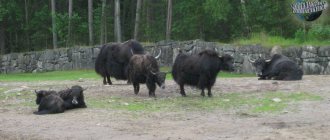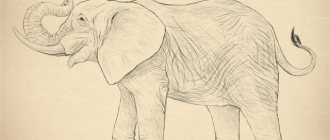- Reports and messages
- Animals
- Amur tiger
The Ussuri or Amur tiger is the largest wild cat on Earth.
The height of an adult predator is 120 cm. It weighs up to three hundred kilograms and reaches three meters in length. Its long, large legs allow it to reach speeds of up to 80 km/h, and its massive jaws deliver a bite so powerful that it can crush bones. Even bears sometimes fall prey to these massive predators. Amur tigers live both in China and in our country in the Far East, where the climate is not warm enough. Therefore, his fur is very thick and warm. A distinctive feature of these predators is the presence of black stripes on their fur. Their thickness and location help zoologists determine which subspecies the tiger belongs to.
The Amur tiger rarely attacks people because there are very few of these cats left in the wild. Over the past hundred years, humans have driven tigers almost to extinction through hunting, killing them for their skin or for use in traditional Chinese medicine.
At the end of the 19th century, tens of thousands of tigers roamed China and Russia. Now there are about five hundred of them left in the wild, of which about twenty live in their native habitat along the Russian-Chinese border. Tigers have learned to avoid humans, so the likelihood of meeting a tiger is extremely low.
The Amur tiger's diet consists mainly of boar and deer. It also survives on badgers, raccoons and other small mammals. But increased deforestation has reduced the habitat for the predator and similar prey.
Amur tigers typically live 15 years. But very often they die if it’s far below zero outside. There were cases when predators lived up to 50 years.
Ussuri tigers are listed in the Red Book as endangered. In our country there are even programs aimed at protecting these animals. For hunting this predator you can get a very real sentence.
Message-report Amur tiger 5th grade
The Amur tiger (also known as the Ussuri tiger) is the largest species of tigers and the rarest representative of the fauna. The length of the tiger exceeds three meters, and at the withers its height reaches one meter. It weighs more than 300 kg. The fur is very thick and lighter than that of other types of tigers. The pattern of the pattern on its skin is unique. There is no tiger in the world that has exactly the same pattern.
The predator has a beautiful skin color: on a bright red background there are transverse dark brown stripes along the back and sides. Such a bright color serves as camouflage, helping him in the hunt. The habitat is considered to be the banks of the Amur and Ussuri rivers flowing through the Far East. This is where the name Amur tiger comes from. It is listed in the Red Book and is an endangered species of animals. It is prohibited to hunt him. The Chinese are given the death penalty for killing an Amur tiger.
The reasons for the disappearance were: deforestation in the animal’s habitats and a decrease in the amount of tiger food, environmental deterioration, but the main reason was still mass poaching caused by the hunt for the beautiful skin of the animal.
Only this type of tiger is able to survive any harsh winter. Its skin brightens in winter, becomes thicker and very fluffy. He easily mastered life in the snow. His body structure helps him with this. The Amur tiger has wide paws with which it easily moves through high snowdrifts and snow in pursuit of its prey. The predator easily hunts even at night, its vision is 5 times better than that of a human. Being huge in size, the tiger is not hardy. To capture prey, he has to sneak up very close to it, which is helped by the color, which merges with the dry grass. The Amur tiger prefers to lead a solitary lifestyle. Tigers, like all representatives of the cat family, mark the boundaries of their territory with urine.
The Amur tiger easily obtains food not only by hunting, but also by fishing. When the fish goes to spawn, he catches it on the rifts of mountain rivers. The tiger makes up for the lack of vitamins in the body by sometimes eating grass.
Reproduction occurs once every two years. In the spring, a tiger gives birth to offspring. Usually 2-3 tiger cubs are born. They are very similar to kittens, only larger in size. Without teeth and blind. They feed on their mother's milk for up to two months. Then the tigress begins to carry meat for them, and when the cubs are six months old, they accompany their mother on the hunt. She patiently and thoroughly conveys all her experience to her offspring. The tigress overcomes all difficulties alone; the male does not take any part in raising his offspring, although he often lives with them.
In the wild, the Amur tiger lives 16-18 years. Life expectancy in captivity is much longer, approximately 25 years.
Interesting Facts
Finally, a few interesting facts about these amazing creatures of nature.
It's interesting that:
- the Amur tiger has the longest tail of any cat - up to 110 cm;
- Amur is the official name of the breed, Ussuri tiger is an outdated one, often used in fictional stories about the amba, Siberian is often called the animal abroad in the West;
- the striped predator is a “soft” carnivore; it does not pose a threat to the population of its prey, killing only as much as it can eat;
- in running speed, this giant cat is second only to the cheetah, reaching speeds of up to 80 km/h;
- The tiger, unlike the rest of the cat family, loves water very much and swims well.
Report of the Amur Tiger from the Red Book
The tiger is a predatory animal. Belongs to the order of cats. Since the tiger is considered an endangered species, it is listed in the Red Book. There are 12 subspecies in total. Of these, 3 species are extinct.
A rare and endangered species - Amur tigers. They are under guard. They are also called Ussuri or Siberian tigers. Tigers live in the territories of the Amur, Primorsky and Khabarovsk Territories in Russia.
Previously, tigers lived in China and Korea. Soon their numbers decreased significantly. This was due to the deforestation of a large number of forests, and poaching also played an important role in this situation. Due to the destruction of forests, many other animals are also disappearing. So in 3) a catastrophic situation arose; tigers found themselves on the brink of extinction. There were no more than 30 of them left. but thanks to the efforts and protection of the state, their numbers have now increased significantly. There are about 400. Many tigers are in the country's reserves.
You can see a real live tiger in zoos. In zoos they are carefully looked after and taken care of. They help raise their young. Such zoos are Moscow, Rostov, and many others.
The Ussuri tiger looks like a big cat. Grows up to 2-3 meters. The height of this beast is approximately 1 meter. The body weight of an adult reaches 300-350 kg. Although living in the wild, a tiger cannot be larger than 150 kg. Males are large compared to females.
Tigers are distinguished by their enormous strength; it is not worth it for them to carry a carcass the weight of an ordinary horse, and with such a burden they can even jump. Tigers are very fast; only a fast cheetah can overtake them. The Siberian tiger has a very interesting and beautiful coloration. There are dark stripes along the middle of the back, and beautiful iridescent red stripes on the sides. The coloring is quite variegated, but this does not prevent it from camouflaging itself on the ground.
Tigers eat meat. Other animals serve as food for them. The approximate norm for one tiger is about 10 kg of meat. But in natural conditions, tigers are not always able to obtain food for themselves. Sometimes it happens that a tiger walks around cold for several days. But then, having obtained prey, it can immediately eat up to 30 kg of meat. In a year, one tiger destroys and eats up to 50–60 large animals, such as deer and wild boar.
While in search of food, tigers can travel up to 50 km. But mostly they try not to go far from their usual place where he lives. Tigers store subcutaneous fat so that they can survive in winter, when it is very cold and there is practically no food. A tiger may even die without food in winter. In natural conditions, a tiger lives for about 15 years, and in a zoo it can live up to 30. Tigers are very strong, so he has no special enemies, but only a big brown bear can cope with him.
Protecting tigers is the task not only of the state, but also of every caring person.
1, 2, 3, 4, 5 the surrounding world. Briefly from the red book
Other rare species
In addition to the Amur, there are several more equally unique varieties of the majestic tabby cat on Earth.
Malayan tiger
It lives on the Malay Peninsula, in the southern part. Its population is only 800 individuals. Separated from the Indochinese as an independent variety in 2004. The weight of an adult individual reaches 120 kg, length - 200-235 cm. Usually they are content with a territory of 100 km². They are distinguished by their jumping ability - the average male can make a long jump of 10 m.
Sumatran subspecies
Lives in Indonesia on the island of Sumatra. The number of the breed is no more than 500 individuals. It is the smallest of the genus, its body weight does not exceed 120 kg. The lower part of its muzzle is framed by white whiskers, protecting its neck and throat from branches in the dense jungle. It is hidden, therefore there is little information about the breed. Its small size helps this mammal survive in tropical forests.
South China species
The rarest. According to the latest reports from scientists, its population consists of 59 representatives, all of which live in captivity. It is believed that this animal is already extinct in nature. They weigh a little more than the previous ones - 170 kg. In natural conditions they prefer mountains and hills. Unlike its brothers, it hunts not ungulates, but primates, fish and porcupines. An organization to save the species undertook an experiment to relocate several individuals to South Africa. It is known that the adaptation was successful, and several pairs even gave birth to offspring in the new habitat.
Extinct
Just half a century ago, there was a greater diversity of tigers living on Earth. Some of them did not survive the surge in poaching and urbanization of the 20th century.
Balinese view
Found on the Indonesian island of Bali. It had short, bright orange fur; among the rare stripes on the animal’s skin there were dark spots. Was destroyed by hunters. The last representative was killed in 1937.
Javanese
Represented a close relative of the Balinese. Some researchers even believe that this is one breed, divided territorially. External difference from others was expressed in the close arrangement of stripes on the body in relation to each other. Believed to have gone extinct in the 1980s, some zoologists still believe it may have survived.
Turanian
It is also called Caspian. The tiger was similar in size and structure to the Amur tiger and is considered its direct ancestor. Its color was distinguished by wider and longer stripes of dark brown color. Residents of Central Asia, where most of the population lived, called it “julbars” - a traveling leopard, because this animal could migrate over distances of more than a thousand kilometers. Extinct by 1957
Popular message topics
- Plants
Unfortunately, as recent studies have shown, plant populations have declined greatly over the past three hundred years. The reason for this is the irresponsible and unforgivable attitude of people towards nature. However, do not forget - Mongolia
At the crossroads of the trade route that connected some ancient countries of Asia, the country of Mongolia is located. The entire life of the country and its development was formed exclusively under the influence of China, Tibet and India. For a long time Mongolia was under the yoke of the Chinese - Lermontov's childhood
Now is a time when it is difficult for young people. Why? We ask ourselves this question. If only because in our youth our desires far outstrip our capabilities. And, although, feeling like an adult,
What does it eat?
It feeds mainly on large ungulates, and if such food is not enough, it hunts cattle and dogs.
The daily meat consumption rate is 10 kilograms.
If the prey is large, the tiger hides the meat in a secluded place, returning within a few days to finish eating. Also good at fishing. During spawning it catches fish.
It does not attack people itself, only in cases of danger, irritation and prolonged hunger.
Place of residence
This species of predator lives in the south-eastern territory of Russia, on the banks of the Amur River, in Manchuria and even in the DPRK. The largest number of tigers at this moment are in the Lazovsky district, in the Primorsky Territory.
A comfortable area for a tiger to live is a mountainous river area with trees such as oak and cedar. An adult tiger can live on an area of up to 2,000 square kilometers without problems and with maximum comfort. The female can live alone in an area of up to 450 square kilometers.











